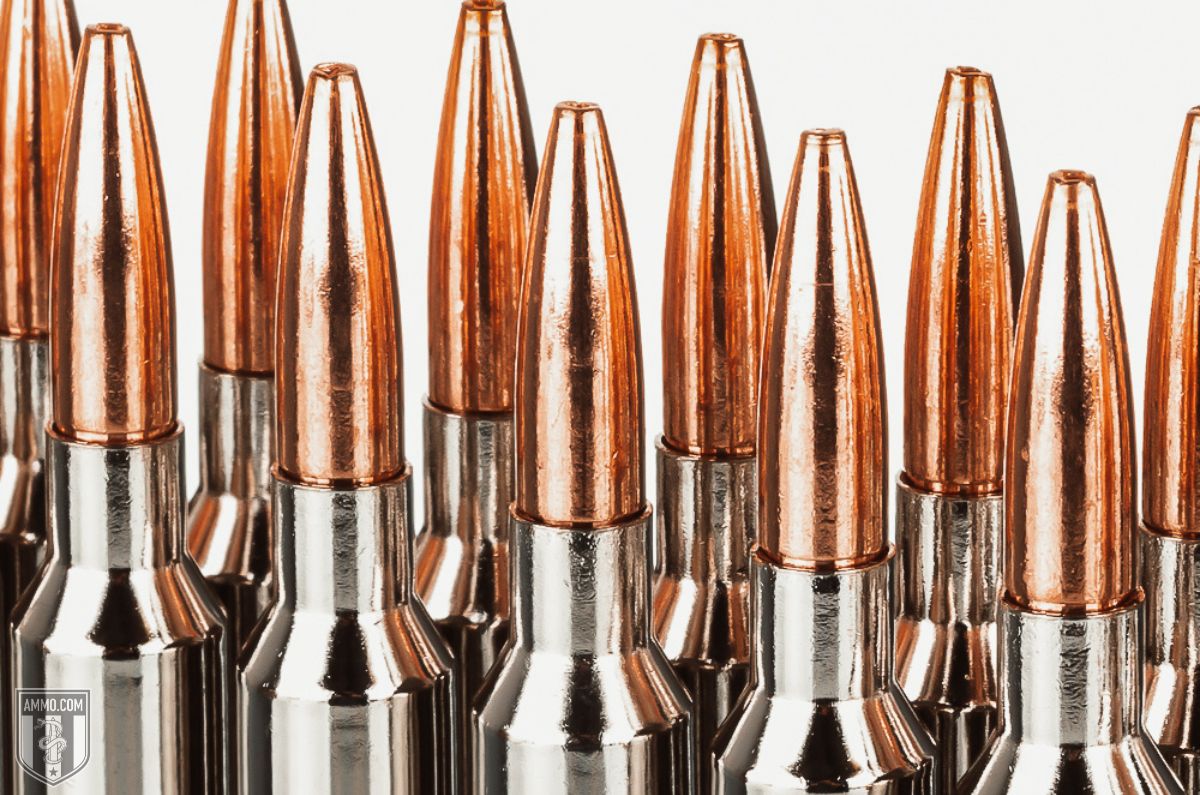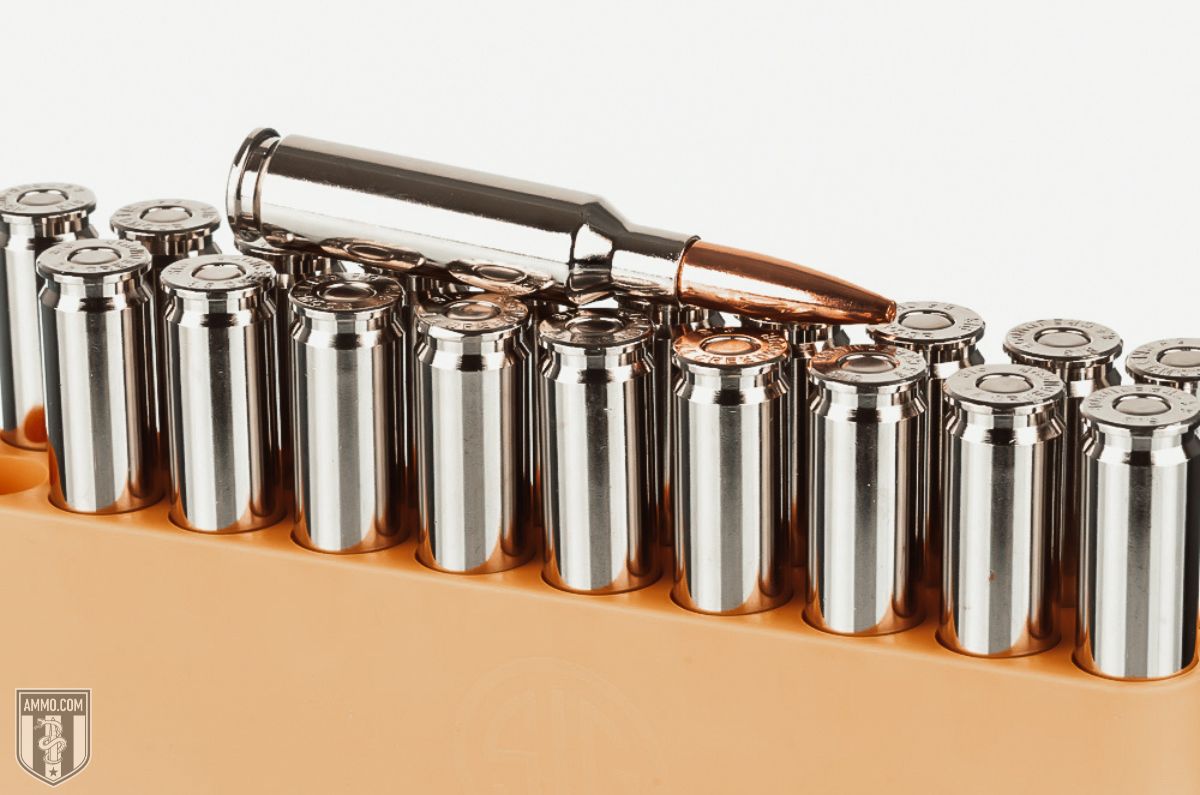28 Nosler vs 6.5 Creedmoor: A Long Range Hunting Cartridge Comparison
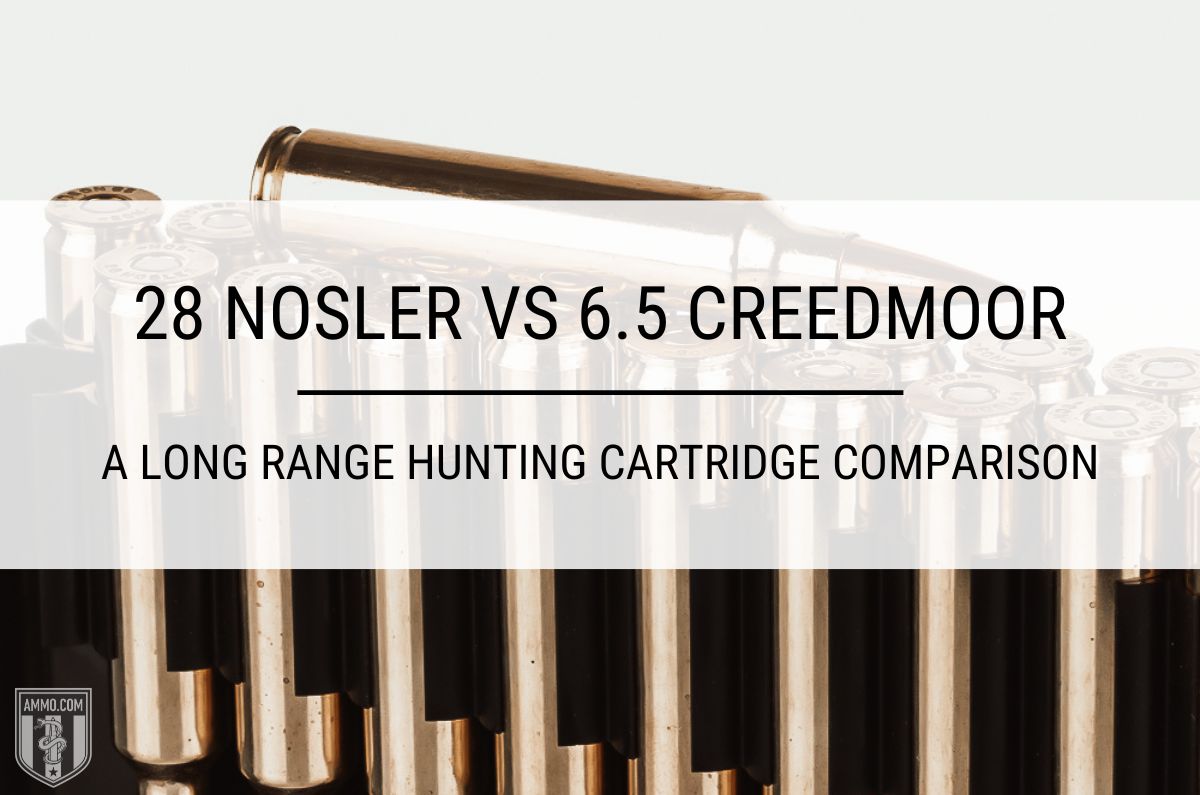
If you’re into precision rifle shooting, then chances are that you’ve heard of the 28 Nosler and 6.5 Creedmoor. These two modern centerfire rifle cartridges excel at long range shooting and can deliver sub-MOA levels of accuracy at ranges of 1,000 yards and more with proper loads.
However, each rifle cartridge was developed with a very different intended purposes in mind. The 6.5 Creedmoor was initially marketed as a long range competition round while the 28 Nosler was developed primarily for big game hunting.
With the widespread acceptance and meteoric rise in popularity of the 6.5 Creedmoor, some shooters started taking it into the woods. Taking note of this change in perspective, several ammo companies started offering expanding bullets for the 6.5 CM as it started to transition into a hunting cartridge.
Most hunters would agree that the 6.5 Creedmoor is powerful enough for whitetail, mule deer, and pronghorn, but does it have the stopping power need to take down big game like elk? Or would you be better served with the potent terminal ballistics of the 28 Nosler for these larger animals?
In this article, we will evaluate the 6.5 Creedmoor vs 28 Nosler to help you understand the differences between the two and give you a clearer idea of which cartridge is best for your shooting and hunting needs.
What is the difference between 6.5 Creedmoor and 28 Nosler?
The main difference between the 6.5 Creedmoor and 28 Nosler is that the 6.5 Creedmoor fires 0.264” diameter bullets compared to 0.284” diameter bullets for the 28 Nosler. The 28 Nosler generally fires bullets between 150 and 175 grains while the 6.5 Creedmoor fires lighter bullets between 95 and 147 grains.
Cartridge Specs
When evaluating centerfire cartridges, it’s a good idea to analyze the cartridge specs to gain more knowledge of each.
The 6.5 Creedmoor is the older cartridge of the two, being released in 2007 in part due to a gripe session between legendary Service Rifle competitor, Dennis DeMille, and Dave Emary, the senior ballistician for Hornady Ammunition at the time.
The round was developed by necking down a 30 Thompson Center case to accept a 6.5mm or 0.264” diameter bullet.
Although developed more recently in 2015, the 28 Nosler draws its heritage from an older safari round, the 404 Jeffery, which was modified to accept a 7mm or 0.284” diameter bullet.
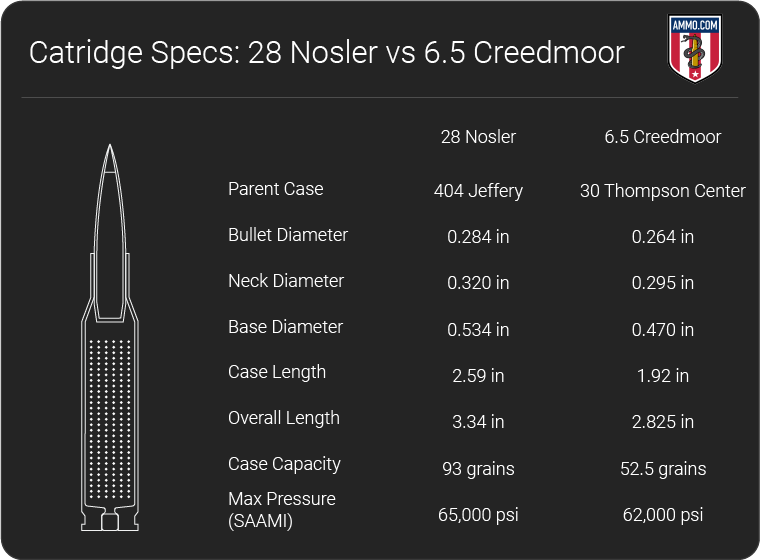
The 404 Jeffery sired the majority of Nosler’s cartridge line, namely the 30 Nosler, 26 Nosler, and 33 Nosler as well as other magnum cartridges like the 7mm Remington Magnum (7mm Rem Mag) and Winchester’s 300 WSM.
Perhaps the most obvious difference between these two rounds is their size, as the 28 Nosler stands almost a half inch taller than the 6.5 CM in terms of overall length (3.34” vs 2.825”). The case length of the 28 Nosler measures 2.59”, which is also considerably longer than the 6.5 Creedmoor’s case at 1.92”.
The 28 Nosler is also wider than the 6.5 CM with a base diameter of 0.534” compared to 0.47”, respectively.
The larger case of the 28 Nosler also gives it a considerably higher case capacity of 93 grains compared to 52.5 grains for the 6.5 CM. This roughly translates to 77% more case capacity for the 28 Nosler.
However, even with 77% more powder, the maximum chamber pressures for both rounds are similar per SAAMI specs. The 28 Nosler is rated at 65,000 psi compared to 62,000 psi for the 6.5 Creedmoor.
Based on all this data, what inferences can we draw? Looking at the two rounds, the 28 Nosler is clearly the larger of the two. It fires heavier bullets and has considerably higher case capacity. This disparity will likely give the 28 Nosler a slight edge in ballistics which will be paid for with heavier recoil.
Recoil
The 6.5 Creedmoor has considerably less recoil than the 28 Nosler.
Recoil is an important consideration when purchasing a new rifle as a round with heavy recoil will be more difficult to control and will slow your rate of follow up shots. The potential for flinching is also an issue for cartridges with heavy recoil.
Free Recoil is affected primarily by muzzle velocity (FPS), powder charge, bullet weight, and firearm weight.
For this comparison we will analyze two popular rounds for long range hunting, the 175 gr Accubond Long Range traveling at 3,125 fps for 28 Nosler and the Hornady 143 gr ELD-X Precision Hunter for the 6.5 Creedmoor with a muzzle velocity of 2,700 fps.
The hunting rifle selected for this comparison will be the Savage 110 High Country, as this is a popular bolt-action rifle for elk hunting and is offered in both cartridges for a true “apples to apples” comparison. The average weight for Savage 110 is 8.5 pounds.
Given these rounds, the 28 Nosler will have a free recoil of 34 ft-lbs while the 6.5 Creedmoor will have 14 ft-lbs of free recoil. That’s nearly a 2.5x difference in terms of recoil.
This drastic difference in recoil clearly illustrates the design differences between these two rifle cartridges.
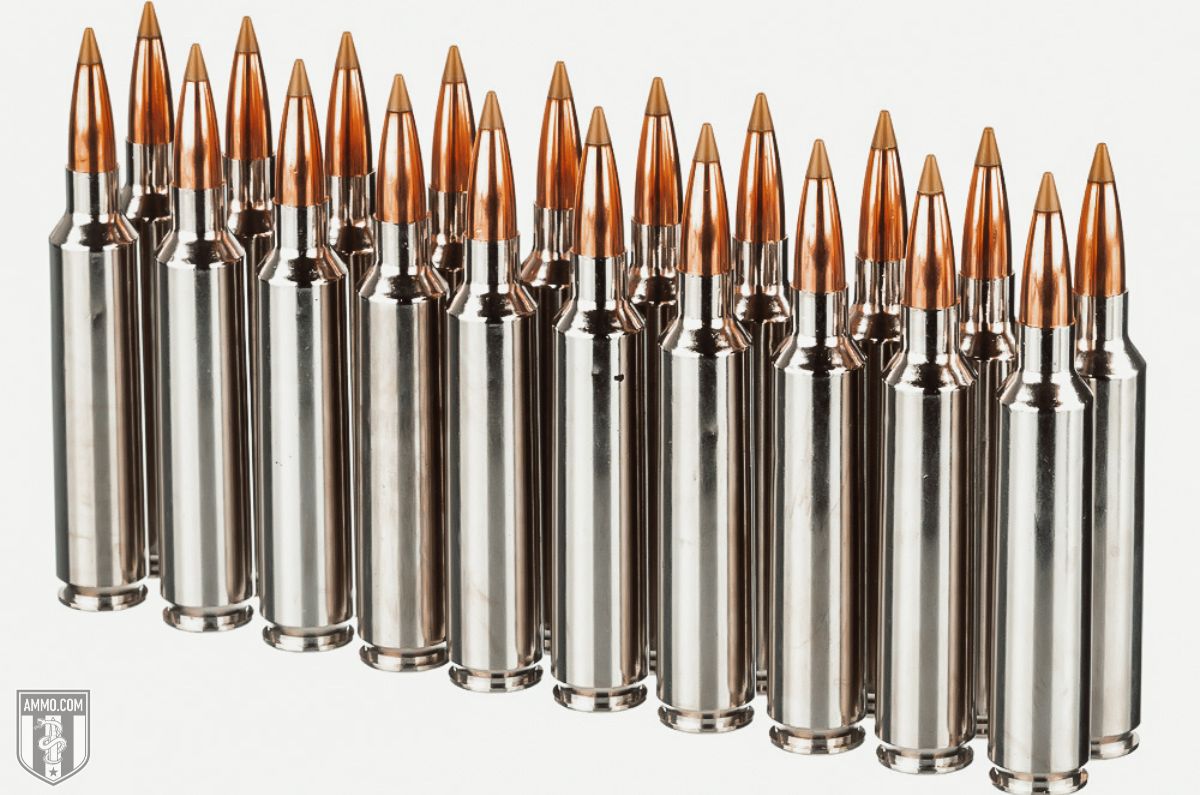
The low recoil of the 6.5 CM makes it ideal for long range shooting competitions where the utmost levels of accuracy are needed. On the other hand, the heavier projectiles and larger powder charge of the 28 Nosler means its bullets can retain their kinetic energy more efficiently at range which is needed for big game hunting.
Muzzle Velocity, Kinetic Energy, and Trajectory
If you frequent any shooting or hunting forums, you are likely aware that proponents of the 6.5 Creedmoor proclaim that the round is perfect for all your shooting needs (just ask them). On the other hand, 28 Nosler supporters scoff at recoil, stating that the superior ballistics of the round are worth it.
To evaluate these claims, we will compare four of the most popular factory loads on the market and see how they stack up against each other!
For this comparison, we will analyze two popular options for each cartridge. For 28 Nosler, the 160 gr Ballistic Tip and 175 grain Accubond Long Range loads from Nosler were selected. For the 6.5 Creedmoor we will analyze the Hornady 143 gr ELD-X and the Barnes VOR-TX 127 gr LRX polymer tipped bullet.
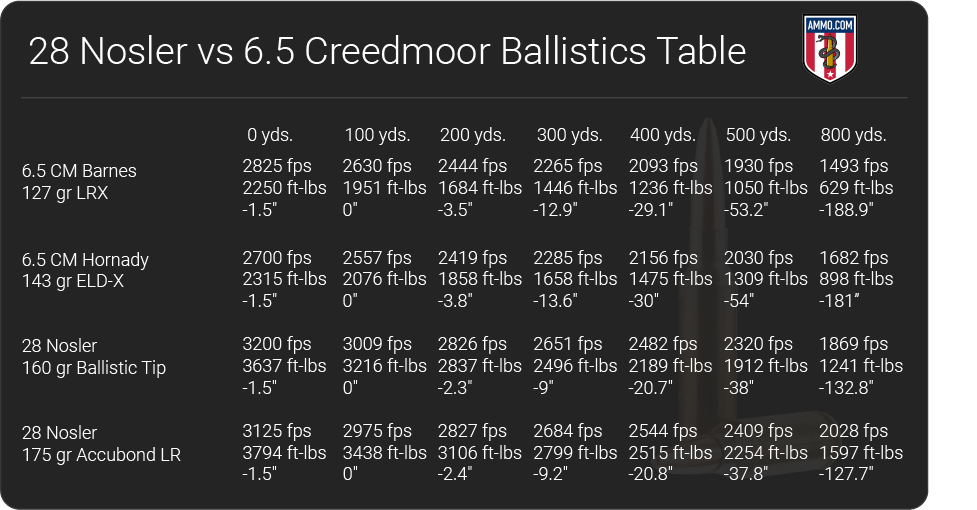
The data from the table above is surprising, as the 28 Nosler simply dominates the 6.5 Creedmoor in all ballistic categories.
In terms of muzzle velocity, the 28 Nosler was approximately 300-400 fps faster for all loads. Although this difference was not massive, the disparity in kinetic energy was considerable.
The 175 gr Accubond factory ammo had the highest muzzle energy at 3,794 foot-pounds while the highest muzzle energy for the 6.5 Creedmoor came from the 143 gr ELD-X at 2,315 foot-pounds. This is about a 64% difference between the two.
In terms of trajectory, the 28 Nosler was flatter shooting by a wide margin especially at longer distances. All four rounds were within about 10” of each other out to 400 yards, however at the 800 yard maker the difference became dramatically apparent.
At 800 yards the two 28 Nosler rounds had -127.7” and -132.8” of bullet drop for the 175 gr Accubond and 160 gr Ballistic Tip bullets, respectively. On the other hand, the two 6.5 CM loads had -181” and -188.9” of bullet drop for the 143 gr ELD-X and 127 gr LRX, respectively.
To put some of these numbers for the 28 Nosler in perspective, the rifle cartridge surpasses the 300 Weatherby Magnum in terms of muzzle velocity while matching the 300 Winchester Magnum and 300 PRC in terms of muzzle energy.
You can read more about how the 28 Nosler compares to other rifle cartridges in these articles:
The 28 Nosler is clearly superior to the 6.5 Creedmoor from a ballistic standpoint, it is incredibly flat shooting with higher muzzle velocity and kinetic energy. However, those advantages are paid for in barrel life.
Barrel Life
The 6.5 Creedmoor will typically have a longer barrel life than the 28 Nosler.
When a cartridge is fired, the powder charge is ignited to push the bullet down the barrel. The resulting flame touches not only the base of the bullet, but the rifling as well. Particularly vulnerable is the rifling at the mouth of the chamber.
Heat is the enemy of barrel life, the hotter you get your barrel the faster the rifling will begin to wear out.
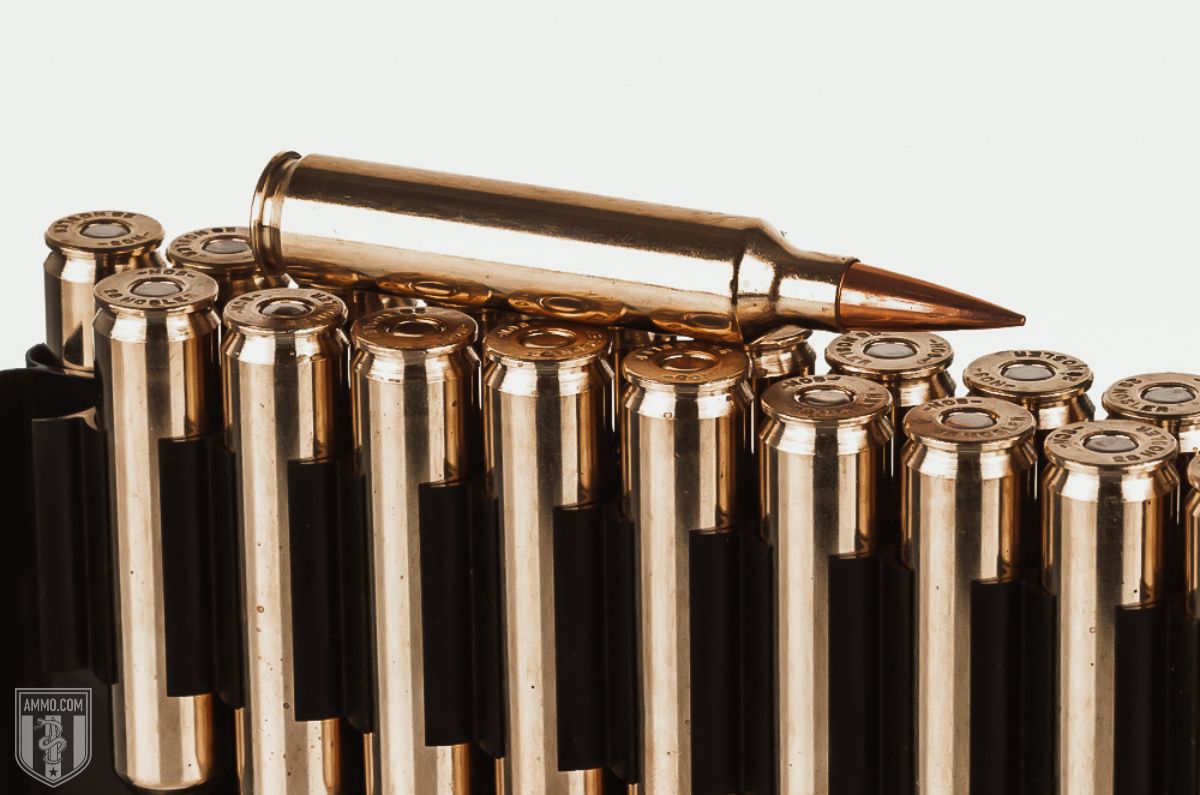
It should be noted that most hunters will not “shoot out” a barrel for multiple seasons with either cartridge. Those who report short barrel life are typically high-volume competition shooters that are shooting near maximum charge handloads to achieve as much muzzle velocity as possible.
To increase your barrel’s lifespan, it’s best to run either factory ammo or handloads below maximum charge. Furthermore, allowing the barrel to cool between strings of fire will also help extend your barrel life.
For a sub-MOA barrel, many shooters report a loss in peak accuracy for 28 Nosler around the 800-round mark, while a 6.5 Creedmoor barrel can hold accuracy until around 2,000-2,500 rounds on average.
The primary difference between the two is the 28 fires a considerably larger powder charge. This means that all the additional heat is focused on a smaller area which increases erosion of the rifling.
Handloaders can perform a technique called “chasing the lands” to help elongate the life of their barrels. As the lands of the barrel erode at the throat, a handloader can measure the levels of erosion and adjust their bullet seating depth to match it.
This helps maintain shot-to-shot consistency for a time, but it is a temporary fix as eventually they will reach the limit of how far out they can seat the bullet in the case.
The bottom line is that most hunters should not experience any appreciable difference in accuracy for multiple seasons, but if a high-volume shooter or hunter is concerned about barrel life then a 6.5 CM barrel will typically last longer.
Ballistic Coefficient and Sectional Density
Ballistic coefficient (BC) is a measure of how aerodynamic a bullet is and how well it will resist wind drift. Sectional density (SD) is a way to evaluate the penetration ability of a bullet based on its external dimensions, design, and weight.
One of the major benefits of 6.5mm and 7mm bullets is their incredibly high ballistic coefficients. The design of both bullets allows them to be incredibly sleek, streamlined, and aerodynamic which helps fight wind drift for longer range shots.
Of the bullets evaluated previously, the 7mm 175 gr Accubond Long Range has the highest BC measured at 0.648 while the 160 gr Ballistic Tip bullet measured a respectable 0.531. However, the 6.5 Creedmoor is right on the 28’s heels as the 143 gr ELD-X has a high BC of 0.625 while the 127 gr LTX measures in at a respectable 0.468 BC.
In terms of penetration and sectional density, both the 6.5 Creedmoor and 28 Nosler are fairly close to one another and are more than adequate for large game. The 175 gr Accubond has the highest SD at 0.310 followed closely by the 6.5mm 143 gr ELD-X at 0.293.
To summarize, the 28 Nosler will have slightly better resistance to wind drift and slightly deeper penetration than the 6.5 Creedmoor.
Hunting

There’s a lot of contention in the hunting community about which of these new cartridges is best for big game.
The 28 Nosler clearly has enough kinetic energy to take down almost any game animal in North America, while the 6.5 Creedmoor offers hunters a softer shooting rifle that allows for better shot placement.
Selecting the best cartridge for your hunting needs primarily depends on what animals and what ranges you plan to hunt.
The 6.5 Creedmoor is perfectly suitable for medium sized game like whitetail, mule deer, pronghorn, and antelope at ranges around 500 yards or less. However, the 28 Nosler is the better option for game animals like elk, moose, and caribou.
I’m sure that the devout 6.5 Creedmoor standard bearers are foaming at the mouth right about now as I did not pontificate the elk-slaying virtues of their beloved rifle cartridge. However, the 28 Nosler is simply the better choice for big game.
This is not to say that you cannot take elk with a 6.5 CM under 300 yards, as you certainly have enough kinetic energy to do so. However, this doesn’t mean that it’s the best choice. You can kill a grizzly bear using a .22 LR with proper shot placement, but that doesn’t mean I’m using a Ruger 10/22 as a guide gun in Alaska.
The 28 Nosler has the power that’s needed to ethically harvest elk and larger game at long range while firing a larger diameter bullet. The 28 Nosler is going to leave a bigger hole, hit harder, and reduce unnecessary suffering of the game animal should your shot placement not be spot on.
To summarize, the 6.5 Creedmoor offers hunters a low recoil, flat shooting package that is easy to carry through thick brush on deer or antelope hunts while the 28 Nosler offers the power needed for long range elk hunting.
Although the 6.5 CM does have the needed 1,500 foot-pounds of energy needed for elk at ranges below 300 yards, the 28 Nosler gives you the added security of ensuring you have enough kinetic energy for elk at all plausible hunting ranges.
Ammo and Rifle Cost/Availability
The 6.5 Creedmoor cannot be beat when it comes to ammo availability and rifle options as it has become the most popular 6.5mm caliber cartridge on the market.
The popularity of the 6.5 CM and ammo availability cannot be understated, as there is no worse feeling then going out to the range and not having ammo available to shoot with.
The Creedmoor offers shooters an extreme amount of versatility, as there are lighter 95 grain bullets loaded for varmints and heavier projectiles that can easily take down whitetail or your next long range precision rifle competition.
Virtually every ammo manufacture like Hornady, Winchester, Remington, Norma, Berger, Barnes, Federal and Browning has some version of 6.5 Creedmoor hunting ammo available. On the other hand, the 28 Nosler currently only has factory ammo available from Nosler, Hornady, and Browning.
In terms of cost, 6.5 CM ammo will generally be less expensive with inexpensive practice ammo going for around $1.20/round and premium hunting ammo costing between $2-3.50/round.
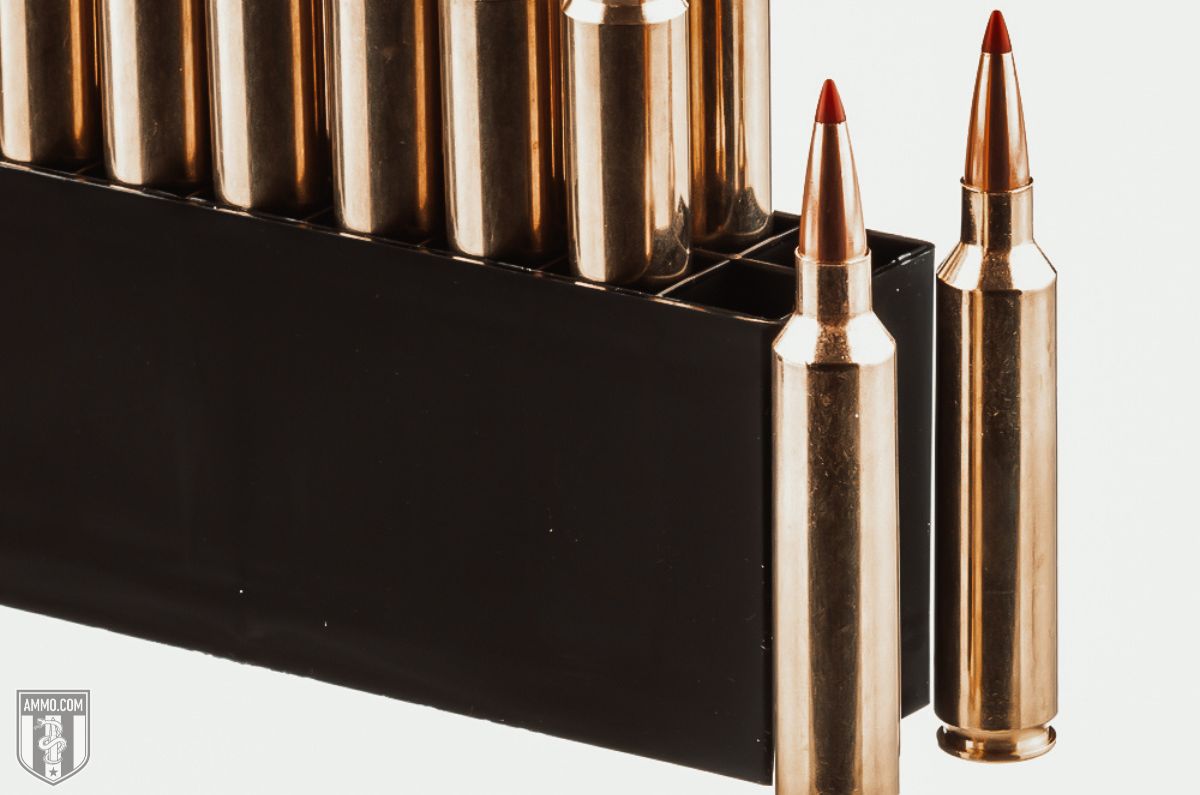
In contrast, the 28 Nosler is more costly to shoot as the least expensive ammo from Nosler runs around $3/round. Hornady and Browning factory loads for 28 Nosler typically run around $4/round while the premium long range ammo from Nosler will punch holes in your wallet to the tune of $6/round.
When it comes to rifle options, the 6.5 Creedmoor continues its dominance as a multitude of bolt-action rifles are available in the caliber.
Entry level bolt-action rifles like the Ruger American and Savage Axis can be had for under $500, while more expensive hunting rifles like a Browning X-Bolt, Savage 110, and Winchester Model 70 can be had for a bit more.
For PRS competitive shooters, the Ruger Precision Rifle and Savage 110 Precision are two out of the box long range rifles ready for the 1,000 yard line. Semi-automatic options for the 6.5 CM are also available in the FN SCAR, Springfield M1A, and AR-10 pattern rifles.
For the 28 Nosler, bolt-action rifles are your only option circa summer 2022. Savage, Bergara, Browning and Christensen are the primary manufacturers of factory rifles for the 28 Nosler, all of which will cost you over $1,000 or more.
Reloading
Reloading is one method shooters use to reduce their overall cost per round and increase the consistency of their ammo to sub-MOA levels. Furthermore, handloads can be tailored to your rifle to meet your specific shooting needs.
Given the relative difficulty in sourcing ammo for the 28 Nosler, most shooters who opt for this cartridge will choose to reload for it to ensure a steady supply of ammo for the range.
Although 6.5 Creedmoor is considerably more common, shooters still enjoy reloading for the 6.5 to ensure the utmost levels of accuracy and consistency.
Bullets for 6.5mm are relatively easy to come by as this bullet diameter is also fired in the 6.5 Grendel, 6.5x55 Swiss, 264 Win Mag, 260 Remington, 6.5-.284 Norma, and 6.5 PRC.
On the other hand, the 7mm caliber bullets are not as common as the American classic 30-caliber. However, cartridges like the 7mm Rem Mag, 7x57 Mauser, 280 Ackley Improved, and 7mm-08 all fire the same bullets so there are options available.
Bullet manufacturers like Nosler, Barnes, Berger, and Hornady have a wide variety of bullet weights and profiles available for both calibers.
However, special care should be taken when ordering large quantities of bullets for the 28 Nosler to ensure that you are ordering the proper bullet diameter. It can be confusing to new handloaders that 0.284” diameter bullets are labeled as 7mm when they truly measure 7.2mm in diameter.
A true 7mm bullet (0.277”) fired by rounds like the 270 Winchester will often be labeled as “270 caliber” to avoid any confusion. Just make sure that you order the correct diameter bullet and contact the manufacturer if you have any questions.
Sourcing brass will be more difficult for the 28 Nosler as it is a newer cartridge. Nosler and Hornady are the primary suppliers of new, unprimed 28 Nosler brass while 6.5 Creedmoor cases are readily available from virtually every manufacturer that offers factory new brass.

Final Shots: 6.5 Creedmoor vs 28 Nosler
The 6.5 Creedmoor and 28 Nosler are two centerfire rifle cartridges that were developed for long range target shooting and hunting.
The 28 Nosler is the younger and larger of the two. Superior to the 6.5 Creedmoor in every ballistic category, the 28 Nosler is viewed by many as the ideal 1,000 yard cartridge and can easily be utilized for elk hunting past 800 yards.
Although the 28 Nosler has numerous ballistic advantages, these come at the cost of punishing recoil and criminally short barrel life.
On the other hand, the 6.5 Creedmoor is a round that built a rock-solid following in the long range shooting community. With minimal recoil and a flatter trajectory than a 308 Winchester, the 6.5 Creedmoor has cemented its competition circles and has successfully transitioned into a hunting cartridge as well.
Although the 6.5 CM is an excellent cartridge for deer hunting, its kinetic energy leaves something to be desired when it comes to hunting elk and larger game.
Most shooters will opt for the 6.5 Creedmoor, as low recoil and ammo versatility are appealing to hunters and long range marksmen alike. However, if you want the most power you can possible attain with a 7mm bullet, then look no further than the mighty 28 Nosler as it won’t let you down so long as your shot placement is on point.
No matter which cartridge you choose, make sure you stock up on ammunition here at Ammo.com and I’ll see you on the range!
Ammo Comparisons
- .308 vs 5.56
- 6.5 Creedmoor vs .308
- .300 Blackout vs .308
- .300 Win Mag vs .308
- .243 vs .308
- .308 vs .30-06
- 7mm-08 vs .308
- .270 vs .308
- 7.62x39 vs .308
- .223 vs .308
- .338 Lapua vs .308
- .380 ACP vs 9mm
- .223 vs 5.56
- .300 Blackout vs 5.56
- 9mm vs 45 ACP
- 9mm vs 40 S&W
- .357 SIG vs 9mm
- 10mm vs 9mm
- 9mm vs 9mm Luger
- .243 vs .270
- .300 Win Mag vs .30-06
- .270 vs .30-06
- .40 vs .45
- 38 Special vs 357
- 9mm vs 40 vs 45
- 5.56 vs 7.62x39
- 338 Lapua vs .30-06
- .30-30 vs .30-06
- 300 PRC vs 338 Lapua
- .30-06 vs 7mm
- 300 Win Mag vs 338 Lapua
- 300 PRC vs 300 Win Mag
- 300 WSM vs 300 Win Mag
- 338 Win Mag vs 338 Lapua
- 12 Gauge vs 20 Gauge
- 10mm vs 357 Mag
- .30-30 vs 7.62x39
- 224 Valkyrie vs 22-250
- 17 HMR vs 22 Mag
- 7.62x39 vs .300 Blackout
- 45 ACP vs 45 Auto
- 45-70 vs 30-30
- 300 Blackout vs 223
- 357 Magnum vs 9mm
- 350 Legend vs 300 Blackout
- 224 Valkyrie vs 223
- 45 ACP vs 38 Super
- 6.5 Grendel vs .308
- 17 HMR vs 22 LR
- 10 Gauge vs 12 Gauge
- 22-250 vs 223
- 45 Colt vs 45 ACP
- 350 Legend vs 30-30
- 5.7x28 vs 223
- 5.7 vs 9mm
- 5.56 vs 5.7
- 22 vs 9mm
- Buckshot vs Birdshot
- 450 Bushmaster vs 308
- 450 Bushmaster vs 223
- Buckshot vs Slug
- 6.5 Grendel vs 5.56 vs 223
- 6mm ARC vs 6.5 Grendel
- 44 vs 45
- 458 SOCOM vs 5.56
- 357 vs 44
- 32 ACP vs 380
- 300 Win Mag vs 338 Win Mag vs 338 Lapua Mag
- 450 Bushmaster vs 458 SOCOM vs 50 Beowulf
- 6mm Creedmoor vs 6.5 Creedmoor
- TMJ vs FMJ
- 44 Special Vs 44 Magnum
- 45 90 vs 45 70
- 6.8 Western vs 6.8 SPC
- 50 Beowulf vs 50 BMG
- 26 Nosler vs 6.5 PRC
- 28 Gauge vs 410
- 6.8 SPC vs 5.56
- 6.8 SPC vs 6.5 Grendel
- 6.8 Western vs 7mm Rem Mag vs .28 Nosler
- 6.8 Western vs 6.5 Creedmoor
- 22 Hornet vs 223
- 6.8 Western vs 6.5 PRC
- .410 vs 12 Gauge
- .410 vs 20 Gauge
- 22 LR vs 22 Mag
- 6mm ARC vs 243
- 7mm-08 vs 270
- 243 vs 6.5 Creedmoor
- Nickel vs Brass Casing
- 204 Ruger vs 223
- 50 Beowulf vs 5.56
- 260 Remington vs 6.5 Creedmoor
- 6mm Remington vs 243
- 28 Nosler vs 300 PRC
- 50 Beowulf vs 50 AE
- 22 Nosler vs 22-250
- 450 Marlin vs 45-70
- 300 Win Mag vs 300 Norma
- 458 SOCOM vs 300 Blackout
- 38-55 vs 45-70
- 22 Hornet vs 22 LR
- 300 Norma vs 338 Lapua
- 338 Lapua vs 50 BMG
- 28 Nosler vs 300 Win Mag
- 28 Nosler vs 6.5 Creedmoor
- 204 vs 22-250
- 458 SOCOM vs 45 70
- 44 40 vs 45 70
- 6.8 SPC vs 6.5 Creedmoor
- 450 Bushmaster vs 30-06
- 7mm Rem Mag vs 300 Win Mag
- 30 Carbine vs 223
- 25-06 vs 30-06
- 26 Nosler vs 28 Nosler
- 16ga vs 12ga
- 30 06 vs 7.62 x54R
- 9mm Makarov vs 9mm Luger
- 350 Legend vs 223
- 30 Carbine vs 5.56
- 6.5x55 vs 6.5 Creedmoor
- 6.5 Creedmoor vs 270 vs 25-06
- M193 vs M855
- 450 Bushmaster vs 458 SOCOM
- 6.5 Grendel vs 6.5 Creedmoor
- 350 Legend vs 5.56
- .277 Fury vs 6.8 SPC
- 277 Fury vs 300 Win Mag
- 10mm vs .45 ACP
- 277 Fury vs 223
- 6.8 SPC vs 300 Blackout
- 6.5 PRC vs 6.5 Creedmoor
- 277 Fury vs 308
- 277 Fury vs 6.5 Creedmoor
- 350 Legend vs 450 Bushmaster
- 277 Fury Vs 5.56 NATO
- 10mm vs 40S&W
- 32 ACP vs 9mm
- 32 Special vs 9mm
- 8.6 Blackout vs 300 Blackout
- 30 Super Carry vs. 9mm
- 5.56 vs 9mm
- .50 Action Express vs 9mm
- 7.62x25 vs. 9mm
- 10mm vs 44 Magnum
- 300 Blackout vs 300 Win Mag
- 6.5 Grendel vs 300 Blackout
- 460 Rowland vs 10mm
- 300 RUM vs 300 PRC
- 300 Norma vs 300 PRC
- 45 GAP vs 45 ACP
- 7mm PRC vs 300 Win Mag
- 300 PRC vs 6.5 Creedmoor
- 300 PRC vs 308
- 357 SIG vs 357 Mag
- 7.62x39 vs 7.62x51
- 243 Win vs 223 Rem
- 30 Nosler vs 300 PRC
- 6.5 Creedmoor vs. 30-06 Springfield
- 450 S&W vs. 44 Magnum
- 6.5 Creedmoor vs. 300 Win Mag
- 454 Cassull vs. 45-70 Govt
- 454 Cassull vs. 44 Mag
- 7.62x54r vs. 308 Winchester
- 22 ARC vs. 223 Rem
- Subsonic vs. Supersonic Ammo


